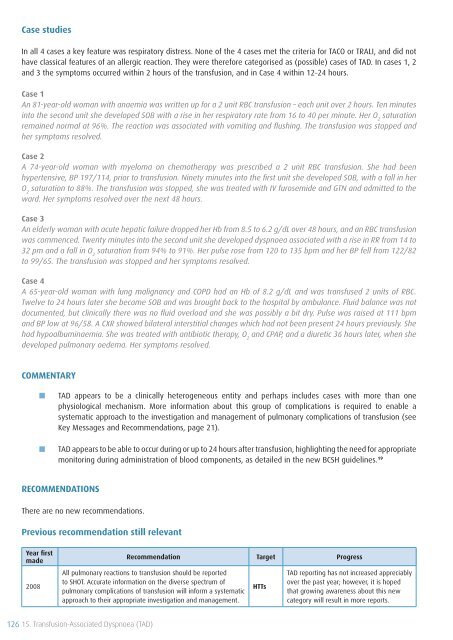SHOT Annual Report 2009 - Serious Hazards of Transfusion
SHOT Annual Report 2009 - Serious Hazards of Transfusion
SHOT Annual Report 2009 - Serious Hazards of Transfusion
Create successful ePaper yourself
Turn your PDF publications into a flip-book with our unique Google optimized e-Paper software.
Case studies<br />
In all 4 cases a key feature was respiratory distress. None <strong>of</strong> the 4 cases met the criteria for TACO or TRALI, and did not<br />
have classical features <strong>of</strong> an allergic reaction. They were therefore categorised as (possible) cases <strong>of</strong> TAD. In cases 1, 2<br />
and 3 the symptoms occurred within 2 hours <strong>of</strong> the transfusion, and in Case 4 within 12–24 hours.<br />
Case 1<br />
An 81-year-old woman with anaemia was written up for a 2 unit RBC transfusion – each unit over 2 hours. Ten minutes<br />
into the second unit she developed SOB with a rise in her respiratory rate from 16 to 40 per minute. Her O 2<br />
saturation<br />
remained normal at 96%. The reaction was associated with vomiting and flushing. The transfusion was stopped and<br />
her symptoms resolved.<br />
Case 2<br />
A 74-year-old woman with myeloma on chemotherapy was prescribed a 2 unit RBC transfusion. She had been<br />
hypertensive, BP 197/114, prior to transfusion. Ninety minutes into the first unit she developed SOB, with a fall in her<br />
O 2<br />
saturation to 88%. The transfusion was stopped, she was treated with IV furosemide and GTN and admitted to the<br />
ward. Her symptoms resolved over the next 48 hours.<br />
Case 3<br />
An elderly woman with acute hepatic failure dropped her Hb from 8.5 to 6.2 g/dL over 48 hours, and an RBC transfusion<br />
was commenced. Twenty minutes into the second unit she developed dyspnoea associated with a rise in RR from 14 to<br />
32 pm and a fall in O 2<br />
saturation from 94% to 91%. Her pulse rose from 120 to 135 bpm and her BP fell from 122/82<br />
to 99/65. The transfusion was stopped and her symptoms resolved.<br />
Case 4<br />
A 65-year-old woman with lung malignancy and COPD had an Hb <strong>of</strong> 8.2 g/dL and was transfused 2 units <strong>of</strong> RBC.<br />
Twelve to 24 hours later she became SOB and was brought back to the hospital by ambulance. Fluid balance was not<br />
documented, but clinically there was no fluid overload and she was possibly a bit dry. Pulse was raised at 111 bpm<br />
and BP low at 96/58. A CXR showed bilateral interstitial changes which had not been present 24 hours previously. She<br />
had hypoalbuminaemia. She was treated with antibiotic therapy, O 2<br />
and CPAP, and a diuretic 36 hours later, when she<br />
developed pulmonary oedema. Her symptoms resolved.<br />
COMMENTARY<br />
■■<br />
■■<br />
TAD appears to be a clinically heterogeneous entity and perhaps includes cases with more than one<br />
physiological mechanism. More information about this group <strong>of</strong> complications is required to enable a<br />
systematic approach to the investigation and management <strong>of</strong> pulmonary complications <strong>of</strong> transfusion (see<br />
Key Messages and Recommendations, page 21).<br />
TAD appears to be able to occur during or up to 24 hours after transfusion, highlighting the need for appropriate<br />
monitoring during administration <strong>of</strong> blood components, as detailed in the new BCSH guidelines. 19<br />
RECOMMENDATIONS<br />
There are no new recommendations.<br />
Previous recommendation still relevant<br />
Year first<br />
made<br />
2008<br />
Recommendation Target Progress<br />
All pulmonary reactions to transfusion should be reported<br />
to <strong>SHOT</strong>. Accurate information on the diverse spectrum <strong>of</strong><br />
pulmonary complications <strong>of</strong> transfusion will inform a systematic<br />
approach to their appropriate investigation and management.<br />
HTTs<br />
TAD reporting has not increased appreciably<br />
over the past year; however, it is hoped<br />
that growing awareness about this new<br />
category will result in more reports.<br />
126 15. <strong>Transfusion</strong>-Associated Dyspnoea (TAD)












